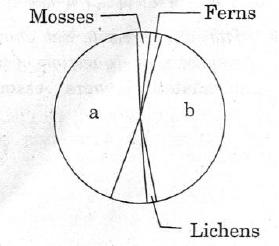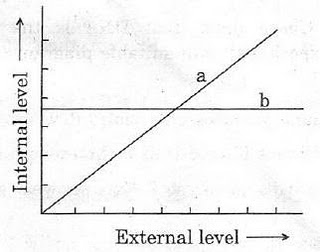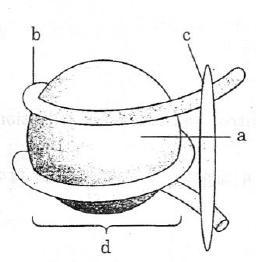(Paper) CBSE Class XII : Biology Exam Paper Year 2009 (Outside Delhi)
Disclaimer: This website is NOT associated with CBSE, for official website of CBSE visit - www.cbse.gov.in
CBSE Class XII : Biology Exam Paper Year 2009 (Outside Delhi)
-
Time allowed : 3 hours
-
Maximum Marks: 70
General Instructions:
(i) All questions are compulsory.
(ii) This question paper consists of four Section A, B, C and D. Section A
contains 8 questions of one marks each, Section B is of 10 questions of two
marks each, Sections C is of 9 questions of three marks each and Sections D is
of 3 questions of five marks each.
(iii) There is no overall choice. However, an internal choice has been
provided in one question of 2 marks, one question of 3 marks and all the three
questions of 5 marks weightage. A student has to attempt only one of the
alternatives in such questions.
(iv) Wherever necessary, the diagrams drawn should be neat and properly
labeled.
SECTION – A
1. When and at what end does the ‘tailing’ of hnRNA take place?
2. Name the type of flower which favours cross pollination.
3. Name the type of cells the AIDS virus enters into after getting in the human body.
4. Name the unlabelled areas ‘a’ and ‘b’ of the pie chart representing the biodiversity of plants showing their proportionate number of species of major taxa.

5. According to hardy – Weinberg’s principal the allele frequency of a population remains constant. How do you interpret the Change of frequency in a population?
6. A boy of ten years had chicken-pox. He is not expected to have the same disease for the rest of his life. Mention how it is possible.
7. Which one of the following is the baker’s yeast used
in fermentation?
Saccharum barberi, Saccharomyces cerevisiae, Sonalika.
8. Why is bagging of the emasculated flowers essential during hybridization experiments?
SECTION – B
9. What are recombinant proteins? How do bioreactor help in their production?
10. (a) Name the lymphoid organ in humans where all
the blood cells are produced.
(b) Where do the lymphocytes produced by the lymphoid organ mentioned above
migrate and how do they affect immunity?
11. Draw a vertical section of a maize grain and label (i) pericarp, (ii) scutellum, (iii) coleoptiles and (iv) radical.
OR
Where are the Leydig cells present ? What is their role in reproduction?
12. Explain the dual function of AUG codon.Give the sequence of bases it is transcribed from and its anticodon.
13. Explain the cause of algal bloom in a water body in a water body. How does it affect an ecosystem?
14. List the specific symptoms of typhoid. Name its causative agent.
15. Name the pioneer and the climax species in a water body. Mention the changes observed in the biomass and the biodiversity of the successive seral communities developing in the water body.
16. How is DNA isolated in purified form a bacterial cell?
17. Explain metastasis. Why is it fatal?
18.
(a) Name the molecule ‘X’ synthesised by ‘i’ gene. How does this molecule get
inactivated?
(b) Which one of the structural genes codes for β-galactosidase?
(c) When will the transcription of this gene stop?
SECTION – C
19. Fertilization is essential for production of seed,
but in some angiosperms seeds develop without fertilization.
(i) Give an example of an angiosperm of seeds without fertilization. Name
the process.
(ii) Explain the two ways by which seeds develop without fertilization.
20. Explain any three measures which will control vehicular air pollution in Indian cities.
21. (a) Why do the symptoms of malaria not appear
immediately after the entry of sporazoites into the human body when bitten by
female Anopheles? Explain.
(b) Give the scientific name of the malarial parasite that causes
malignant malaria in humans.
22.
(a) What is the diagram representing?
(b) Name the part a, b and c.
(c) In the eukaryotes the DNA molecules are organised within the nucleus. How
is the DNA molecule organised in a bacterial cell in absence of a nucleus?
23. Ornithologists observed decline in the bird population in an area near a lake after the setting of an industrial unit in the same area. Explain the cause responsible for the decline observed.
24. Recently a girl baby has been reported to suffer from haemophilia. How is it possible? Explain with the help of a cross.
OR
What are satellite DNA in a genome ? Explain their role in DNA fingerprinting.
25.
(a) Write your observation on the variations seen in the Darwin’s finches
shown above.
(b) How did Darwin explain the existence of different varieties of finches on
Galapagos Islands?
26. Name and explain the techniques used in the separation and isolation of DNA fragments to be used in recombinant DNA technology.
27. The following graph represents the organismic response to certain environmental condition (e.g. temperature):

(i) Which one of these, ‘a’ or ‘b’ , depicts conformers?
(ii) What does the other line graph depict?
(iii) How do these organisms differ from other with reference to homeostasis?
(iv) Mention the category to which humans belong.
SECTIONS – D
28. How did Hershey and Chase prove that DNA is the hereditary material? Explain their experiment with suitable diagrams.
OR
A particular garden pea plant produced only violet flowers:
(a) Is it homozygous dominant for the trait or heterozygous?
(b) How would you ensure its genotype ? Explain with the help of crosses.
29. How does the pollen mother cell develop into mature a mature pollen grain? Illustrate the stages with labeled diagrams.
OR
Study the flow chart given below. Name the hormones involved at each stage
and explain their functions.
Hypothalamus → Pituitary → Ovary → Pregnancy
30. How is a transgenic tobacco plant protected against Meloidegyne incognitia? Explain the procedure.
OR
(a) Name the source of Taq polymerase. Explain the advantage of its use in
biotechnology.
(b) Expand the name of the enzyme ADA. Why is this enzyme essential in the human
body? Suggest a gene therapy for its deficiency.

